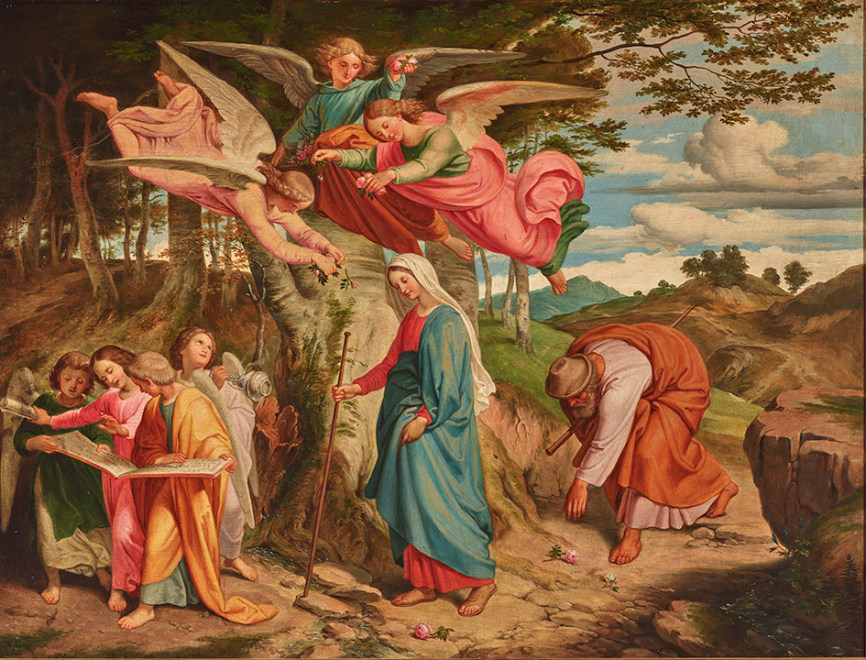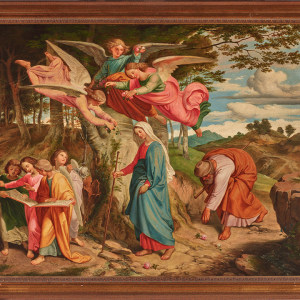Provenance
Sale, Dorotheum, Vienna, 5 November, 2009, lot 139
Private collection, California (acquired at the previous sale)Catalogue note
Joseph Führich (1800-1876) was born in the small Bohemian town Kratzau (today’s Chrastava in Czechoslovakia Czech). He was the son of a local painter and early on showed promising talent considering that the instruction he received from his father may have been deemed insufficient. Basically, an autodidact in those years he developed a fascination for the rustic wayside shrines and chapels he grew up with, a youthful passion perceptible throughout his mature work. Later on, Führich would certainly be more than capable of grand dramatic gestures, as in his monumental frescoes Stations of the Cross for the Viennese church St. John Nepomuk (1844-1846). But he again and again favored heartfelt, intimate depictions, above all of the Madonna, and was drawn to the magic of folk piety. “How the spirit that almost imperceptibly breathes through all the lands in which the Church reigns also sanctifies Nature,” he wrote enthusiastically. “Chapels, crosses and simple images serve [the pilgrim] as a reminder of his celestial home and the mystery of our salvation. … I understood this very early on and to this day I remember vividly the impression they made upon me when on beautiful fresh mornings I walked with my father through the countryside.” In one of his most famous paintings, Mary’s Walk Across the Mountains (1841), he would materialize this intimate memory for all to share.
The desire to visualize his personal, almost autobiographical experience might explain the unexpected choice of subject matter, the moment when Mary, pregnant with Jesus, leaves Nazareth to visit her cousin, Elizabeth, on the other side of the mountains. In contrast to the Annunciation or the Visitation, this particular passage, when Mary “went into the hill country” and “with haste into a city of Juda” is only mentioned by Luke (Luke 1:39; Douay-Rheims), and had attracted scarce attention in the visual arts prior to Führich’s composition. The Austrian painter took the opportunity to rethink the possibilities of biblical narration and, infatuated with the pious atmosphere of his native woods, invented a music-filled journey reminiscent of fairy-tale illustrations. Neither the endearing choir of angels nor the angelic group hovering abovehave biblical origins, and their presence evokes Christian legend instead. This is true for the tender motif of the roses scattered on the Virgin’s stony path or the figure of the devout and devoted wanderer who might or might not be Joseph.
Führich’s anecdotal story-telling evokes a charming light-heartedness that goes hand in hand with an overall lyricism. It is as if the painter wanted to translate the sweet sound of the angels’ voices into line and color. This is hardly surprising for a painter dedicated to the idea of a harmony of the arts. But Führich went even further. By placing his divine choir firmly on the ground, he depicts celestial music no longer as an unattainable vision but a concrete model for its earthly counterpart. Losing the nimbus of the supernatural, the angels’ song gains presence in the here and now, an idea further inscribed by the written fixation of the song’s text, “Vox dilectimei.” The score probably refers to a motet by the late Renaissance composer Giovanni Pierluigida Palestrina (1525- 1594), whose rediscovery was part and parcel of the Nazarene resurrection.If the reference to an early modern setting of the Song of Songs to music is unexpected, it represents a rather ambitious, and perhaps no less surprising, intervention in a core discourse of modernist art, the push for a musicalization of the visual arts. In this sense, Mary is not merely on her way to visit her cousin, but Kandinsky as well.
The acquisition of the canvas for Austria’s Imperial Painting Gallery in 1868 added long-lasting visibility to the exiting popularity, and by 1920s Mary’s Walk across the Mountains was undisputedly Führich’s most famous painting. Choosing this work for a full-page illustration of his article on the artists, Gerard Gietman even felt it worthwhile to note that “two of his early pictures … viz. ‘Jacob and Rachel’ and “Mary’s Journey over the Mountains’ sold for five times the original price even during his lifetime.” No surprise then that the artist would soon set out to create a replica of his most cherished, and most lucrative, composition.




